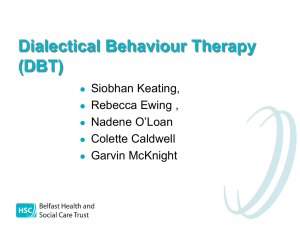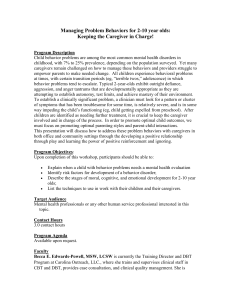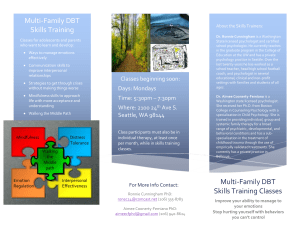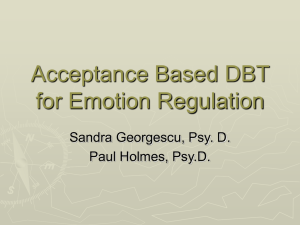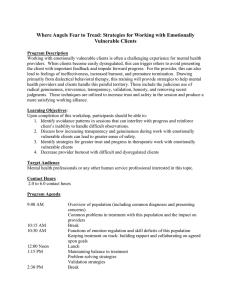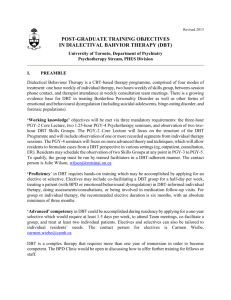ABCs of DBT - NAMI Illinois
advertisement
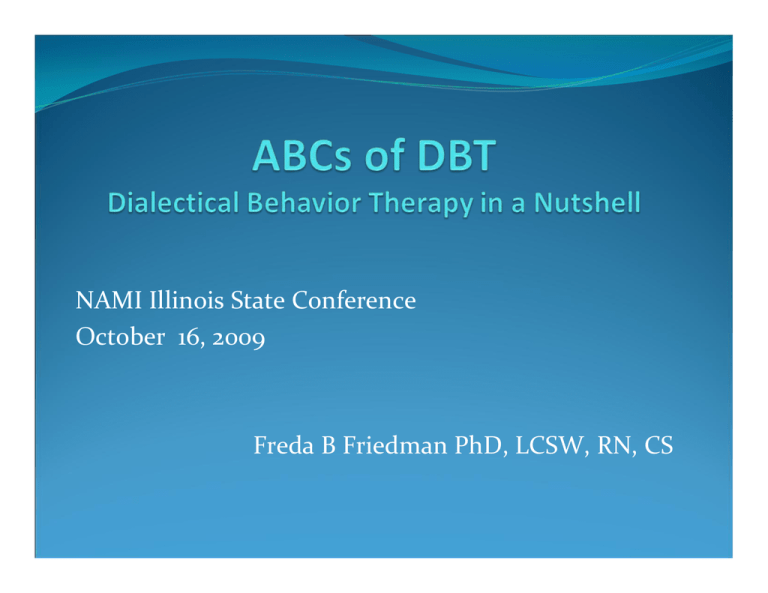
NAMI Illinois State Conference October 16, 2009 Freda B Friedman PhD, LCSW, RN, CS o Components of DBT Developing the ability to think dialectically Mindfulness Skills training individually and in groups Support for therapist, for family o Helping families to apply DBT in their interactions with loved ones o Current research findings and applications o Resources for information, referrals and training Fundamentals of DBT DBT is targeted at clients with emotional vulnerability and poor ability to modulate strong emotions. Vulnerability: a. Very high sensitivity to emotional stimuli b. Very intense response to emotional stimuli c. A slow return to emotional baseline following emotional arousal. Fundamentals of DBT – cont. Emotion modulation – ability to . . . • Inhibit inappropriate behavior related to strong emotions [+ or ‐] • Organize oneself for coordinated action in service of an external goal • Self soothe physiological arousal • Refocus attention in the presence of strong emotion Fundamentals of DBT – cont. Four areas are emphasized: • Acceptance and validation of behavior as it is in the moment • Treating therapy‐interfering behaviors of both client and therapist • The assumption that the therapeutic relationship is essential to the treatment • Dialectic process [persuasive dialogue, focus on reality]. Understanding Dialectics The term Dialectics refers to opposing forces that create a whole or synthesis. DBT focuses on finding a balance in opposing forces. Opposing forces needing a balance can be found in many things all around us, for example: the sun and the moon the seasons Goals of DBT Decrease (and) block dysfunctional responses [that allow escape] Reinforce opposite action [approach] Increase DBT skills Secondary targets Quality of life behaviors Build confidence Build motivation to create a “life worth living” Some core differences between DBT and CBT CBT DBT Focus on change Dialectic of acceptance and change Exposure to distress Exposure to distress with acceptance of distress Problem focus: specific Problem focus: broad, inclusive and use of hierarchy Dialectics of continuously balancing and integrating Acceptance and Change Acceptance based strategies: Validation Distress Tolerance Change based strategies: Opposite action Some DBT skills Components of DBT Treatment Skills training and application in individual therapy and in groups Developing ability to think dialectically Mindfulness Support and consultation for the therapist, for the team and [when appropriate] for the family Skills Training Modules 1. Core Mindfulness [focusing skills] 2. Distress Tolerance [crisis survival skills] 3. Emotion Regulation [de‐escalation skills] 4. Interpersonal Effectiveness [‘people skills’] Module 1: Mindfulness Mindfulness . . . is not a matter of explaining and solving, but of experiencing and describing. Everything begins with lucid indifference. Albert Camus What is mindfulness? Awareness plus Acceptance of the current moment Focusing on one thing, in that moment, without judgment The ability to have awareness of one’s sensory and cognitive experience The ability to discern emotions, verbal descriptions of events, appraisals and judgments of events, memories, perceptions of events from each other And more Reasonable Mind Wise Mind Emotion Mind Practicing Mindfulness Observe [just notice] Describe [put words to an experience] Participate [be involved in what you’re doing] Learn how to notice without necessarily reacting Distinguish between thoughts and facts Bring non‐judgment [neither good nor bad] Be one‐mindful [in the moment] Be effective [focus on what works] Mindfulness Summary You can use these skills to re‐center, calm yourself, better understand your emotions, reflect, or train your brain to stay in the present. Mindfulness Summary – cont. You can sit with your anxiety instead of pushing it away, and observe your thoughts; • listen to yourself; • acknowledge your fears, or apprehensions . . . • In practicing these skills, you can • avoid getting caught up in power struggles with another • avoid taking things personally • listen more fully and understand others . . . Distress Tolerance Skills Crisis Survival Strategies Guidelines for Accepting Reality Crisis Survival Strategies Distracts with “Wise Mind” ACCEPTS Activities Contributing Comparisons Emotions Pushing away Thoughts Sensations Self Sooth the FIVE SENSES Vision Hearing Smell Taste Touch Pros and Cons of Distress Tolerance Tolerating Not Tolerating • More effective in long run • Easier in short run • Harder in short run • Creates more problems in long run Guidelines for Accepting Reality Observing your breath Half smiling Awareness Radical Acceptance Turning the mind Willingness How Families Can Help* 1. 2. 3. 4. 5. 6. 7. Remember that change is difficult to achieve and fraught with fears. Be cautious about suggesting that “great progress” has been made. Progress evokes fears of abandonment. Lower your expectations Set realistic goals that are attainable. Work on one thing at a time. Keep things cool and calm. Express appreciation and validation How Families Can Help – cont. 8. Maintain family routines. There’s more to life than problems, so don’t give up the good times. 9. Find time to talk about light or neutral matters. 10. Managing crisis: Pay attention, but stay calm. 11. Self destructive acts or threats require attention. Don’t ignore. Don’t panic. 12. ALWAYS involve family member in problem solving. 13. Be consistent enough. How Families Can Help – cont. 14. Share concerns about medications or therapist interventions. If you have financial responsibility, you have the right to address your concerns to therapist or doctor. 15. Set limits, but be careful and direct. 16. Do not protect family member from natural consequences of their actions. 17. Do not tolerate abusive treatment. 18. Be cautious about threats and ultimatums. They are a last resort. *From Multiple Family Group Program, McLean Hospital, Harvard University: John Gunderson, MD and Cynthia Berkowitz, MD. Research on DBT Controlled studies show that • The cost of DBT is approximately 50% of treatment at usual [TAU] • Significantly fewer inpatient days • Fewer and less severe self harm behaviors Research on DBT – cont. Seven well‐controlled randomized clinical trials with varying research teams have established DBT as a valid and effective treatment for Borderline Personality Disorder. DBT has had several controlled studies showing effectiveness in treatment of • Eating disorders • Substance abuse disorders • Depressed older adults • Other personality disorders Resources and References TARA NAPD (Treatment and Research Advancement National Association for Personality Disorder). www.tara4bpd.org National Education Alliance for BPD (NEA‐BPD) www.borderlinepersonalitydisorder.com Behavioral Tech LLC www.behavioraltech.org “Frequently Asked Questions about DBT” & “DBT at a Glance” www.BPDCentral.com Mindfulness: www.dbtselfhelp.com
